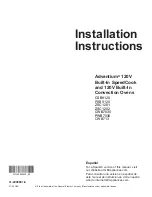
Always remember that times for
cooking, reheating and defrosting
are usually considerably shorter than
with traditional methods of food
preparation.
Excessively long cooking times can
lead to food drying out and burning or
could even cause it to catch fire. There
is also a danger of fire if breadcrumbs,
flowers, herbs etc. are dried in the
microwave oven. Always ensure that
this type of procedure is supervised.
Do not use the microwave function
to heat up cushions or pads filled
with cherry kernels, wheat grains,
lavender or gel, such as those used in
aromatherapy. These pads can ignite
when heated even after they have been
removed from the microwave.
Fire hazard.
Exercise caution when cooking or
reheating food with a high sugar
content, e.g. Christmas pudding. If
heated for too long the sugar may
caramelise or ignite.
Do not use full power to warm
empty dishes. Do not use the
appliance without food, or if it is
incorrectly loaded.
Never cook or reheat food or
liquids in sealed containers or
bottles.
With baby bottles, the screw top
and
teat must be removed. Otherwise
pressure builds up which can cause
the bottle or container to explode,
posing a severe risk of injury.
Before serving, remember to allow
a sufficient standing time and then
always check the temperature of the
actual food itself after taking it out of the
microwave. The temperature of the
container is not an indication of the
temperature of the food in it.
This is
particularly important when
preparing food for babies, children,
and the elderly or infirm.
Shake or stir
baby milk and food thoroughly after
heating, and try it for temperature to
ensure that it will not scald the baby.
When heating food and drink remember
that the heat is created in the food
itself, and that the container will
normally be cooler. The dish is only
warmed by the heat of the food.
When heating liquids, the boiling
rod provided should be placed in
the container.
When heating liquids, milk, sauces etc
in the oven without the boiling rod, the
boiling point of the liquid may be
reached without the production of
typical bubbles. The liquid does not
boil evenly throughout.
Warning and Safety instructions
10











































